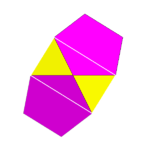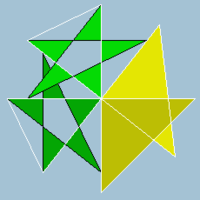Vertex configuration

| Wikimedia Commons has media related to Vertex configurations. |
In geometry, a vertex configuration (or vertex type, or vertex description) is a shorthand notation for representing the vertex figure of a polyhedron or tiling as the sequence of faces around a vertex. For uniform polyhedra there is only one vertex type and therefore the vertex configuration fully defines the polyhedron. (Chiral polyhedra exist in mirror image pairs with the same vertex configuration.)
It is also called a Cundy-Rollett symbol for its usage for the Archimedean solids in their 1952 book Mathematical Models.[1]
A vertex configuration is given as a sequence of numbers representing the number of sides of the faces going around the vertex. A a.b.c means a vertex has 3 faces around it, with a, b, and c sides.
For example 3.5.3.5 means a vertex has 4 faces, alternating triangles and pentagons. This vertex configuration defines the vertex-uniform icosidodecahedron polyhedron.
Vertex figures
A vertex configuration can also be represented graphically as vertex figure showing the faces around the vertex. This vertex figure has a 3-dimensional structure since the faces are not in the same plane for polyhedra, but for vertex-uniform polyhedra all the neighboring vertices are in the same plane and so this plane projection can be used to visually represent the vertex configuration.
Variations and uses
Different notations are used, sometimes with a comma (,), and sometimes a period (.) separator. The period operator is useful because it looks like a product and an exponent notation can be used. For example 3.5.3.5 is sometimes written as (3.5)2.
The order is important and so 3.3.5.5 is different from 3.5.3.5. The first has two triangles followed by two pentagons.
The notation can also be considered an expansive form of the simple Schläfli symbol for regular polyhedra. {p,q} means q p-agons around each vertex. So this can be written as p.p.p... (q times). For example an icosahedron is {3,5} = 3.3.3.3.3 or 35.
The notation is cyclic and therefore is equivalent with different starting points. So 3.5.3.5 is the same as 5.3.5.3. To be unique, usually the smallest face (or sequence of smallest faces) are listed first.
This notation applies to polygon tiles as well as polyhedra. A planar vertex configuration can imply a uniform tiling just like a nonplanar vertex configuration can imply a uniform polyhedron.
The notation is ambiguous for chiral forms. For example, the snub cube has a clockwise and counterclockwise form which are identical across mirror images. Both have a 3.3.3.3.4 vertex configuration.
Star polygons

The notation also applies for nonconvex regular faces, the star polygons. For example a pentagram has the symbol {5/2}, meaning it has 5 sides going around the centre twice. The nonconvex regular small stellated dodecahedron has the Schläfli symbol of {5/2,5} which expands to an explicit vertex configuration 5/2.5/2.5/2.5/2.5/2.
The last, U75, nonconvex uniform polyhedron great dirhombicosidodecahedron has a vertex figure of 4.5/3.4.3.4.5/2.4.3/2. This complex vertex figure has 8 faces that pass around the vertex twice.
Inverted polygons
Faces on a vertex figure are considered to progress in one direction. Some uniform polyhedra have vertex figures with inversions where the faces progress retrograde. A vertex figure represents this in the Star polygon notation of sides p/q as an improper fraction (greater than one), where p is the number of sides and q the number of turns around a circle. For example 3/2 means a triangle that has vertices that go around twice, which is the same as backwards once. Similarly 5/3 is a backwards pentagram 5/2.
All uniform vertex configurations of regular convex polygons
The existence of semiregular polyhedra can be enumerated by looking at their vertex configuration and the angle defect: A set of regular faces must have internal angles less than 360 degees.
NOTE: The vertex figure can represent a regular or semiregular tiling on the plane if equal to 360. It can represent a tiling of the hyperbolic plane if greater than 360 degrees.
For uniform polyhedra, the angle defect can be used to compute the number of vertices. (The angle defect is defined as 360 degrees minus the sum of all the internal angles of the polygons that meet at the vertex.) Descartes' theorem states that the sum of all the angle defects in a topological sphere must add to 4*π radians or 720 degrees.
Since uniform polyhedra have all identical vertices, this relation allows us to compute the number of vertices: Vertices = 720/(angle-defect).
Example: A truncated cube 3.8.8 has an angle defect of 30 degrees. Therefore it has 720/30=24 vertices.
In particular it follows that {a,b} has 4/(2-b(1-2/a)) vertices.
Every enumerated vertex configuration potentially uniquely defines a semiregular polyhedron. However not all configurations are possible.
Topological requirements limit existence. Specifically p.q.r implies that a p-gon is surrounded by alternating a q-gons and r-gons, so either p is even or q=r. Similarly q is even or p=r. Therefore potentially possible triples are 3.3.3, 3.4.4, 3.6.6, 3.8.8, 3.10.10, 3.12.12, 4.4.n (for any n>2), 4.6.6, 4.6.8, 4.6.10, 4.6.12, 4.8.8, 5.5.5, 5.6.6, 6.6.6. In fact, all these configurations with three faces meeting at each vertex turn out to exist.
Similarly when four faces meet at each vertex, p.q.r.s, if one number is odd its neighbors must be equal.
The number in parentheses is the number of vertices, determined by the angle defect.
Triples
- Platonic solids 3.3.3 (4), 4.4.4 (8), 5.5.5 (20)
- prisms 3.4.4 (6), 4.4.4 (8; also listed above), 4.4.n (2n)
- Archimedean solids 3.6.6 (12), 3.8.8 (24), 3.10.10 (60), 4.6.6 (24), 4.6.8 (48), 4.6.10 (120), 5.6.6 (60).
- regular tiling 6.6.6
- semiregular tilings 3.12.12, 4.6.12, 4.8.8
Quadruples
- Platonic solid 3.3.3.3 (6)
- antiprisms 3.3.3.3 (6; also listed above), 3.3.3.n (2n)
- Archimedean solids 3.4.3.4 (12), 3.5.3.5 (30), 3.4.4.4 (24), 3.4.5.4 (60)
- regular tiling 4.4.4.4
- semiregular tilings 3.6.3.6, 3.4.6.4
Quintuples Finally configurations with five and six faces meeting at each vertex:
- Platonic solid 3.3.3.3.3 (12)
- Archimedean solids 3.3.3.3.4 (24), 3.3.3.3.5 (60) (both chiral)
- semiregular tilings 3.3.3.3.6 (chiral), 3.3.3.4.4, 3.3.4.3.4 (note that the two different orders of the same numbers give two different patterns)
Sextuples
- regular tiling 3.3.3.3.3.3
Face configuration for duals
The dual polyhedron can also be listed by this notation, but prefixed by a V. See face configuration.
The faces of semiregular polyhedral duals are not regular polygons, but edges vary in length in relation regular polygons in the dual. For example, one can tell a face configuration of V3.4.3.4 represents a rhombus face since every edge is a V3-V4 type, and V3.4.5.4 will be a kite with two types of edges: V3-V4 and V4-V5.
Notation used in articles
- Uniform polyhedron
- Face configuration
- Catalan solid - Archimedean duals
- Bipyramid - prism duals
- Trapezohedron - antiprism duals
Notes
References
- Cundy, H. and Rollett, A., Mathematical Models (1952), (3rd edition, 1989, Stradbroke, England: Tarquin Pub.), 3.7 The Archimedean Polyhedra, pp. 101-115
- Peter Cromwell, Polyhedra, Cambridge University Press (1977) The Archimedean solids, p 156-167
- Williams, Robert (1979). The Geometrical Foundation of Natural Structure: A Source Book of Design. Dover Publications, Inc. ISBN 0-486-23729-X., Uses Cundy-Rollett symbol
- Grünbaum, Branko; Shephard, G. C. (1987). Tilings and Patterns. W. H. Freeman and Company. ISBN 0-7167-1193-1. (Tilings by regular polygons and star polygons)
- The Symmetries of Things 2008, John H. Conway, Heidi Burgiel, Chaim Goodman-Strass, ISBN 978-1-56881-220-5 (p289 Vertex figures, uses comma separator, for Archimedean solids and tilings)